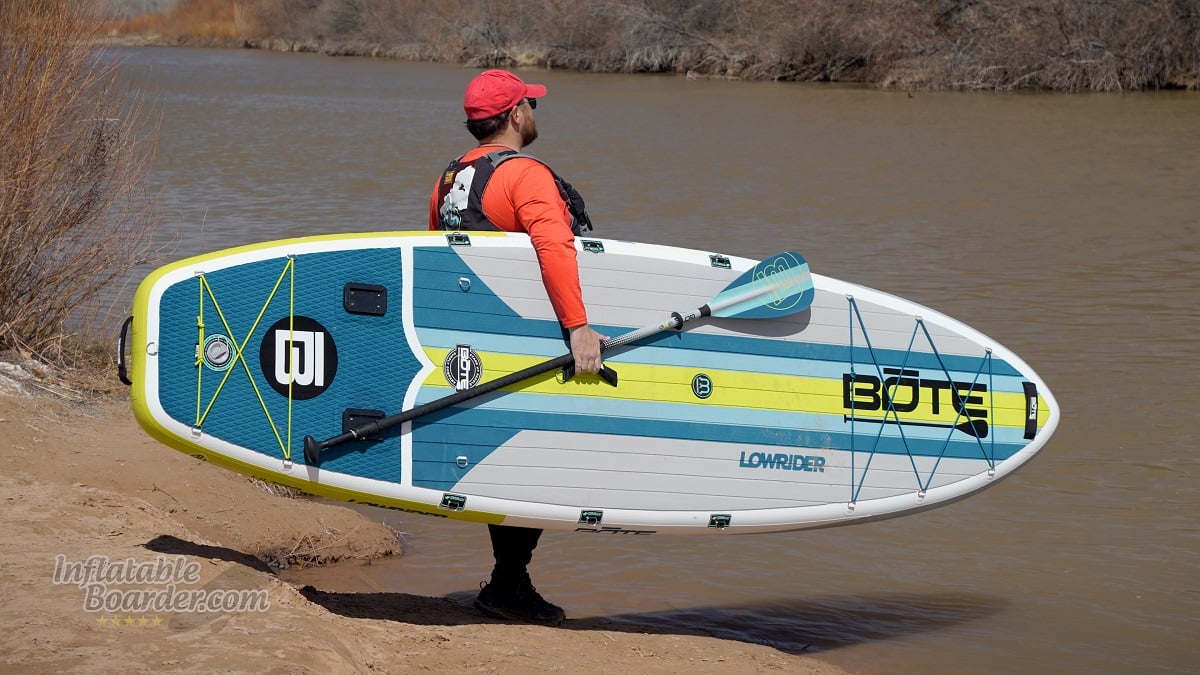
The Bote LowRider 11’6 is a tandem-capable inflatable paddle board and kayak hybrid in one convenient kit.
Bote LowRider 10’6” Solo Review – Overview
The Bote LowRider 10’6 is a fantastic choice for the solo paddle board angler who wants a supremely stable paddle board and a comfortable sit-on-top kayak all in one package. This wide board is great for bringing along all of your fishing accessories while working smaller bodies of water. The Full Trax deck pad also makes it a comfortable ride for your favorite four-legged companion.
— Bote LowRider 10’6” Solo Review Summary and Ratings —
Bote LowRider 10’6” Solo
-
Construction & Durability
-
Features and Versatility
-
Stability
-
Speed
-
Maneuverability
-
Tracking
Overall Score
The Bote LowRider 10’6 Solo is a complete SUP/Kayak Hybrid package for the solo angler.
Pros
- Ultrawide shape provides tons of stability whether sitting, standing, casting, or landing
- 10’6” length keeps the LowRider easily maneuverable for fishing on smaller bodies of water
- Features a full complement of accessory mounting points makes it easy to bring everything you need
- Inflatable kayak seat is comfortable and easy to adjust
- Fiberglass/ABS paddle easily switches between SUP and Kayak
- Wheeled roller bag makes it easy to transport
Cons
- Overall kit is very large and heavy compared to the similarly-size Bote EasyRider 10’4
- Lightweight construction keeps the board weight low, but sacrifices rigidity
- The included kayak seat is comfortable, but there is no compatible foot brace for additional support
Bote LowRider 10’6” Solo Review – Construction and Durability
The Bote LowRider 10’6 is built with Bote’s lightweight AeroUltra construction to keep the – quite large – paddle board to a manageable weight.
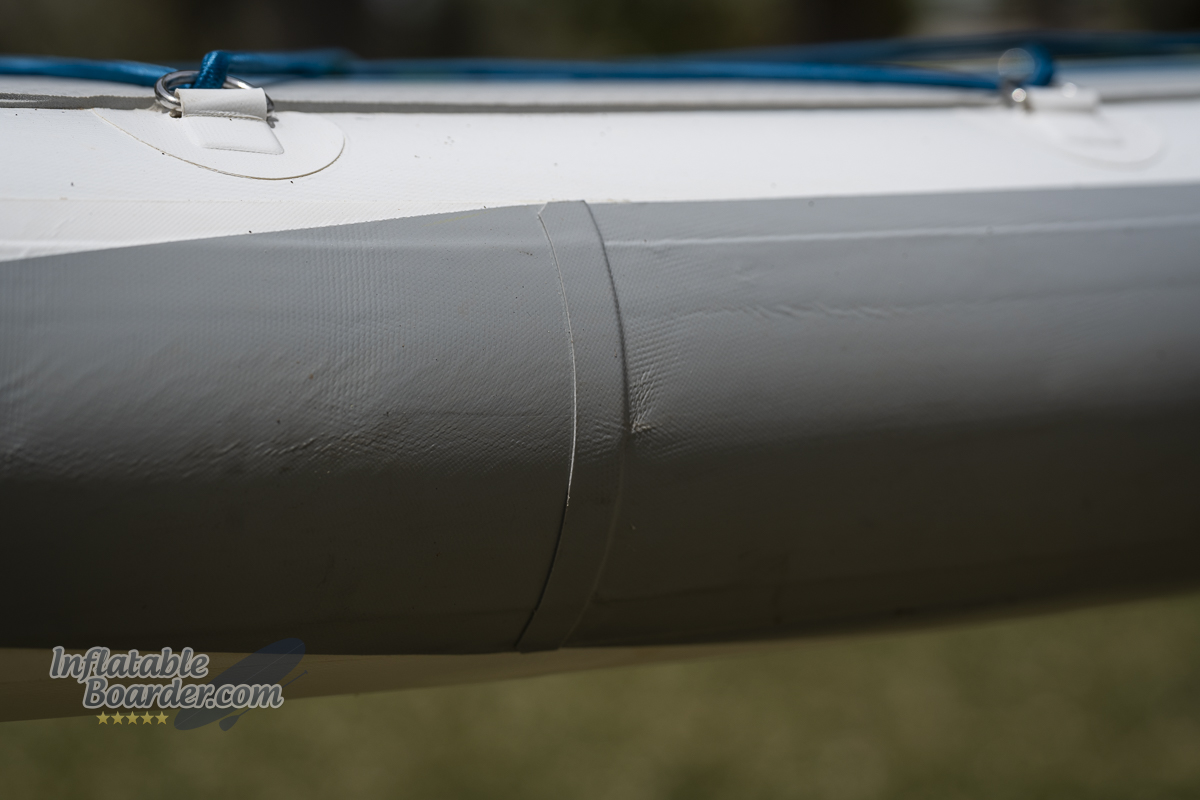
AeroUltra construction uses a single-layer fusion PVC shell and double layer PVC rail.
Bote’s AeroUltra construction is known for creating very lightweight paddle boards, even in large sizes like the LowRider 10’6, however it does come with a few drawbacks.
Inside the LowRider 10’6 is a standard knitted drop stitch core. This includes a layer of knitted polyester fabric for the top and bottom of the board each. These layers are joined together with thousands of dropstitched yarns to keep the LowRider 10’6 flat and give it its six-inch thickness. Knitted cores like this have been a staple of inflatable stand up paddleboards for over a decade.
The top and bottom fabric layers each have a single layer of reinforced PVC tarpaulin mechanically bonded, or fused, to the fabric. This fusion PVC laminate creates a sturdy airtight shell for the paddle board without the extra weight and potential for manufacturing errors with hand-glued layups. The top and bottom of the board are joined together with heat-pressed interior rails to form a strong and airtight bond. Lastly a wider outer layer of reinforced PVC is glued around the rail for additional durability and rigidity.
Once all of the features are installed, the Bote LowRider 10’6 hit our scale at just 21.8 pounds. That’s definitely a light board considering it’s 36” wide!
Bote lists a recommended maximum inflation pressure for the LowRider 10’6 of 15 PSI and a recommended maximum capacity of 300 pounds.
Single layer constructions have come and gone and come again in the stand up paddle board industry. Many current single-layer constructions use updated core materials and other construction techniques to improve on their rigidity – something single layer iSUPs were not known for in the past. However, Bote’s AeroUltra is a fairly simple construction without any additional stiffening elements, and it does show.
In our static-load bend test, we placed 170 pounds of weight on the standing area of the board and measured how much the LowRider 10’6 deflected. Our measured result of 2.32” of bend falls in line with Bote’s other AeroUltra construction boards like the Breeze and the Wulf. This is significantly more bend than our current average of 1.6” from over 100 boards.
Like with all technical data, our bend test is only half of the story. How a board feels on the water is just as, or really more, important than its bend test result.
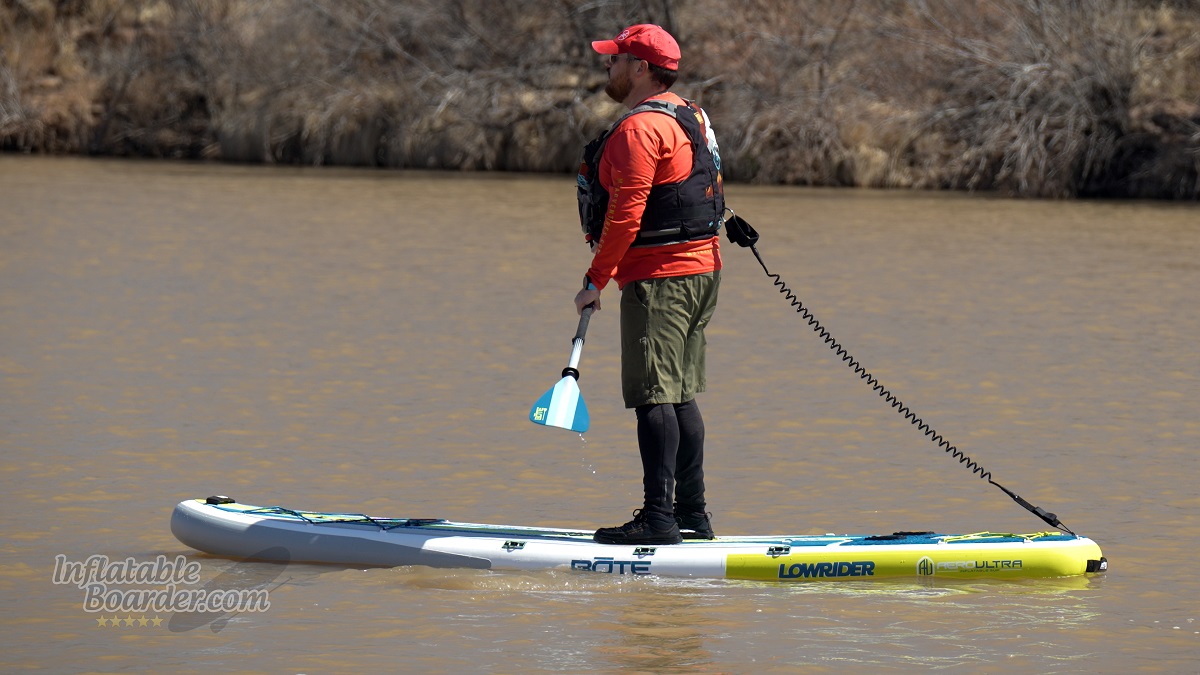
There is some flex in the board while standing and paddling normally, but not enough to be detrimental.
Once inflated and on the water, the LowRider 10’6’s rigidity began to look a bit better. While standing and paddling normally on the board I could feel some flex, but mostly just when I was looking for it. One thing I did notice frequently, though, was the amount of flex and vibration whenever I adjusted my position on the board. However, it was better controlled than the longer LowRider 11’6 Tandem board.
Where I could really feel the LowRider 10’6 flex on the water was any time I wanted to pick up the pace and paddle a bit harder. With the additional body movement and transfer of weight between my feet and my paddle and back again, the LowRider 10’6 did have noticeable flex while paddling quickly.
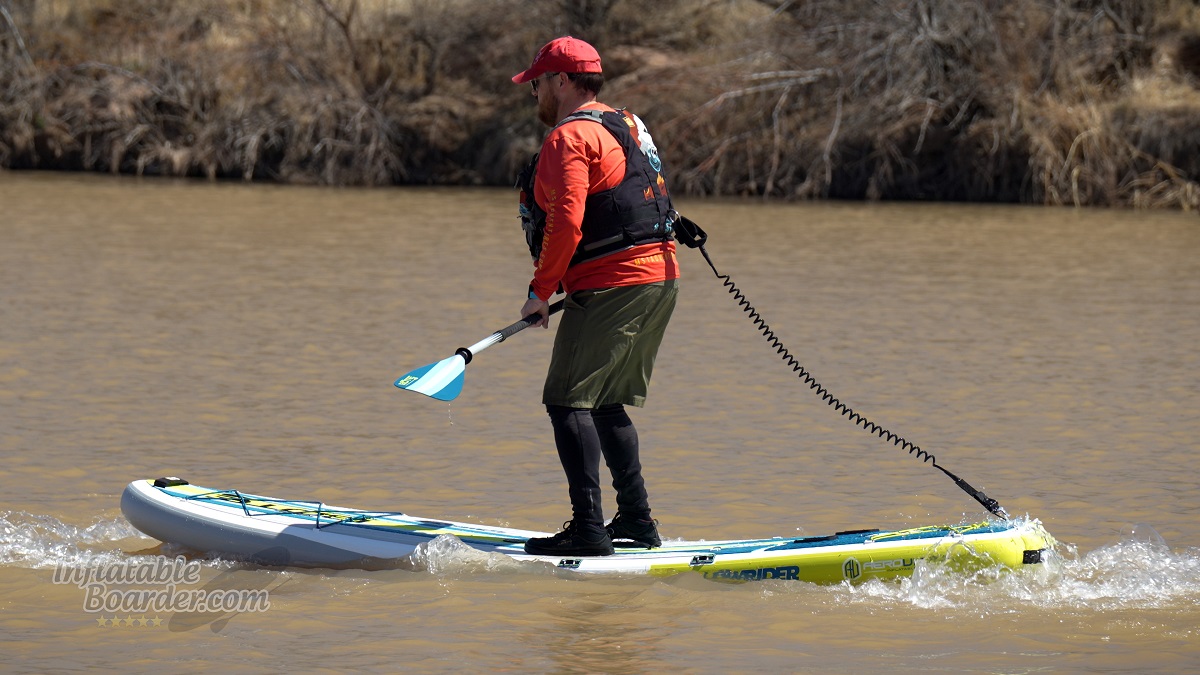
The LowRider 10’6 has a moderate amount of flex with a noticeable rebound feel when it settles back down.
I can’t say that I am surprised by this result on the water. It does track with Bote’s other AeroUltra construction iSUPs. But the question is, how much does it actually impact use of the board?
For most paddlers the actual impact of the flex in the LowRider 10’6 will be minimal to non-existent. Heavier paddlers will notice this more. At 230 pounds I could feel the board flexing fairly regularly and it did result in more of a “pushing” feel through the water rather than a smoother gliding feel. I would recommend paddlers above 220 pounds consider a more rigid construction like the Bote HD Aero with AeroBote dual-layer shell or the Blackfin Model X with a dual-layer composite build. Paddlers under 220 pounds will experience less flex during use. If you are bringing lots of equipment with you for fishing, like a tackle rack, cooler of ice, dry bags, etc. it’s definitely best to distribute the weight as evenly as possible. This will also help reduce the amount of point flex in the board.
Specifications
| Dimensions | |
| Length | 10’ 6” |
| Width | 36“ |
| Thickness | 6“ |
| Weight | |
| Max Capacity | 300 pounds |
| Board Weight | 21.8 pounds |
| Kit Weight (SUP & accessories) | 48 pounds |
| Buying Info | |
| List Price | $799 |
| Warranty | 2 years |
| Returns period | 30 days |
Bote LowRider 10’6” Solo Review – Features, Accessories and Versatility
The Bote LowRider 10’6 is set up for full-day fishing adventures and the Full Trax deck pad make it a comfortable option for passengers and pets.
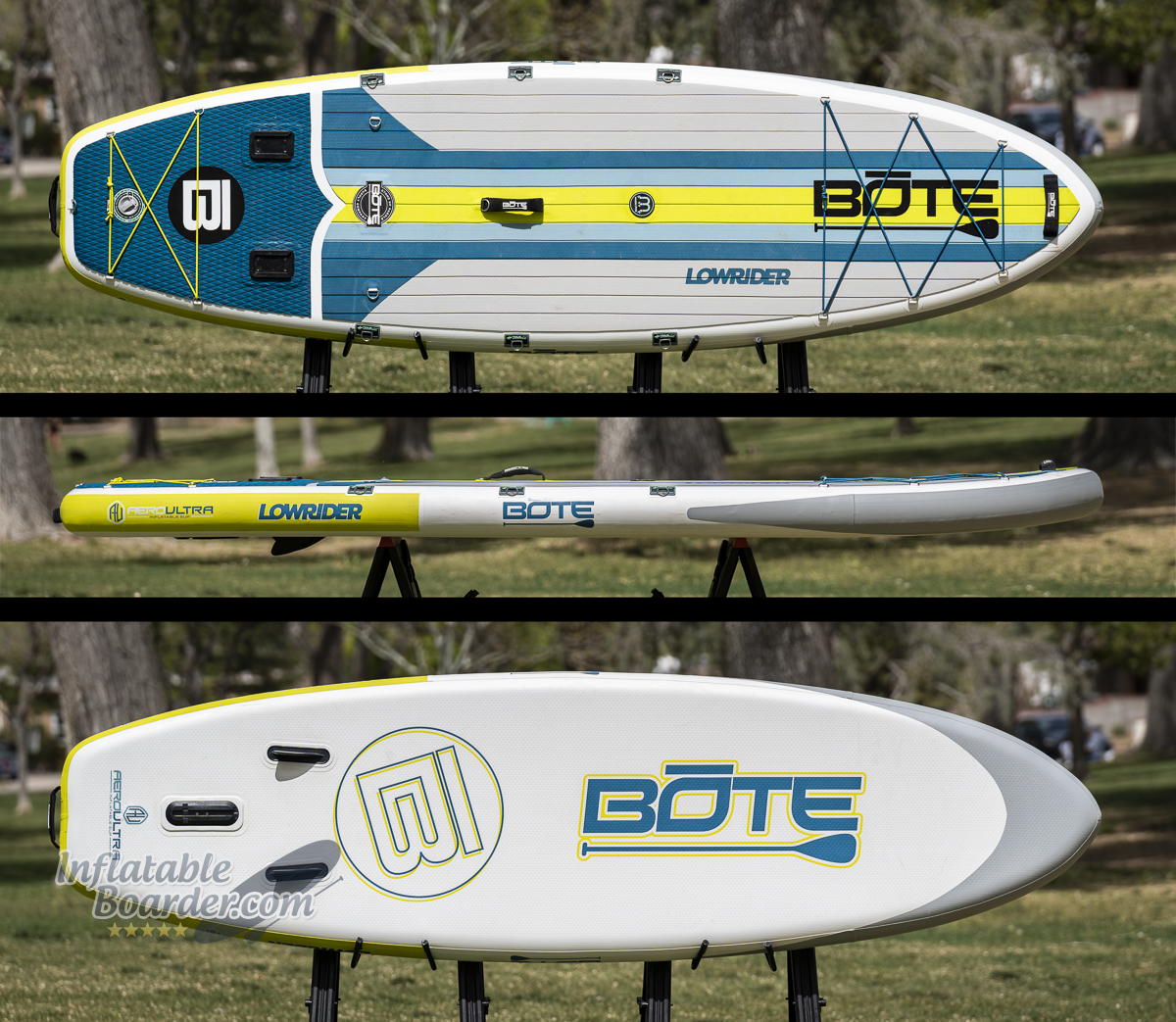
The Bote LowRider 10’6 Solo is 10’6” long, 36” wide, and 6” thick. It has a maximum weight capacity of 300 lbs and weighs just under 22 lbs. The board has a continuously curved shape with a wide nose and tail, but keeps the main standing area close to the maximum width.
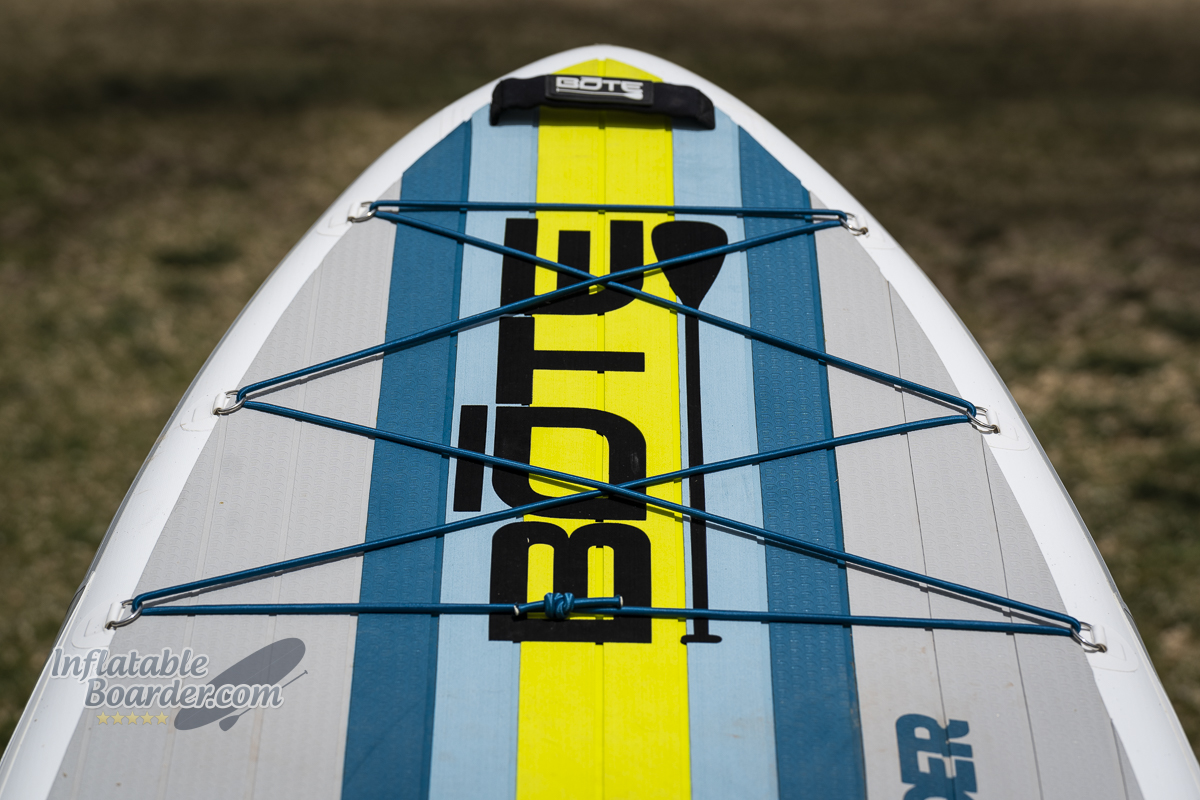
The nose of the board is fairly wide with a mild point and rocker profile. This helps keep the board more stable while still letting it ride up and over mild-to-moderate chop and wake. There’s a large cargo area on the front of the board with an adjustable bungee cord.
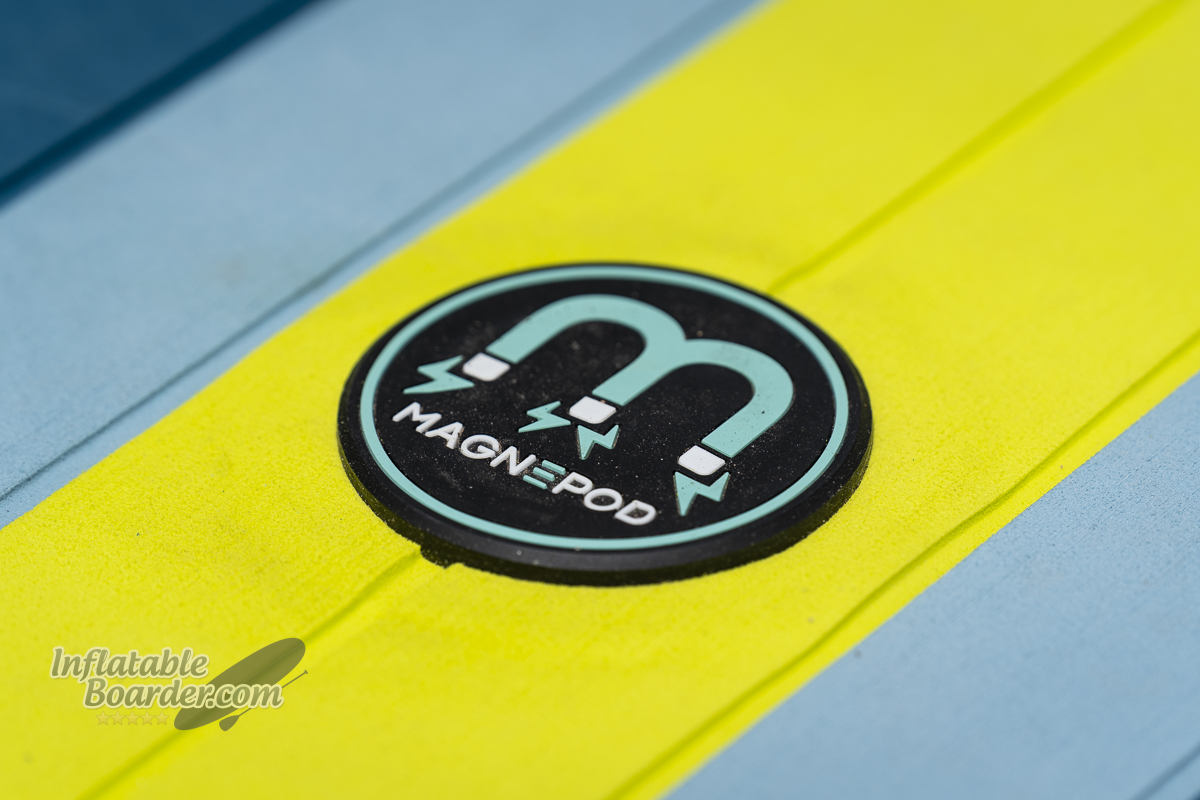
The LowRider 10’6 features a single Bote Magnepod accessory mounting point within easy reach of the main standing area. This strong magnetic system lets you bring along drink tumblers, speakers, and more for quick and easy access without worrying about losing the item if you tilt or bump the board.
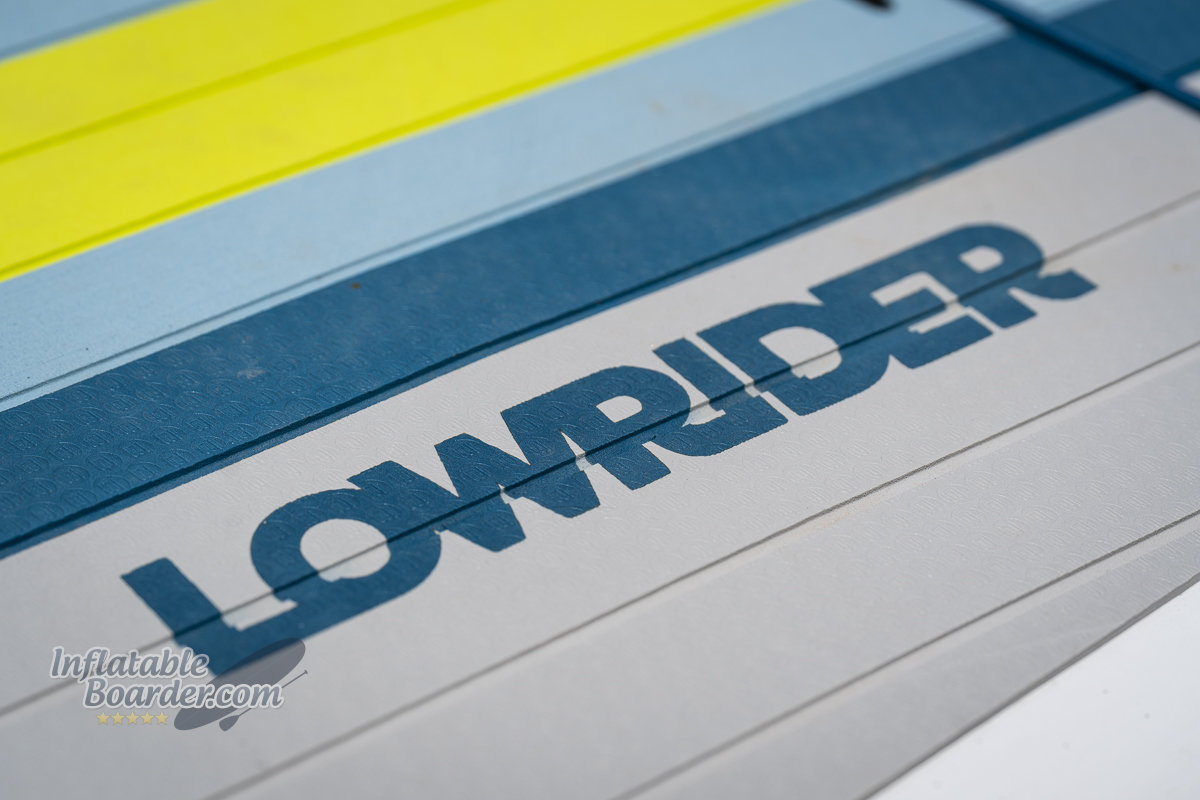
The Full Trax deck pad covers the entire length of the board from nose to tail. The primary standing area is EVA foam with a soft texture in the middle (yellow/light blue) and a logo-embossed texture on the outside (dark blue/gray).
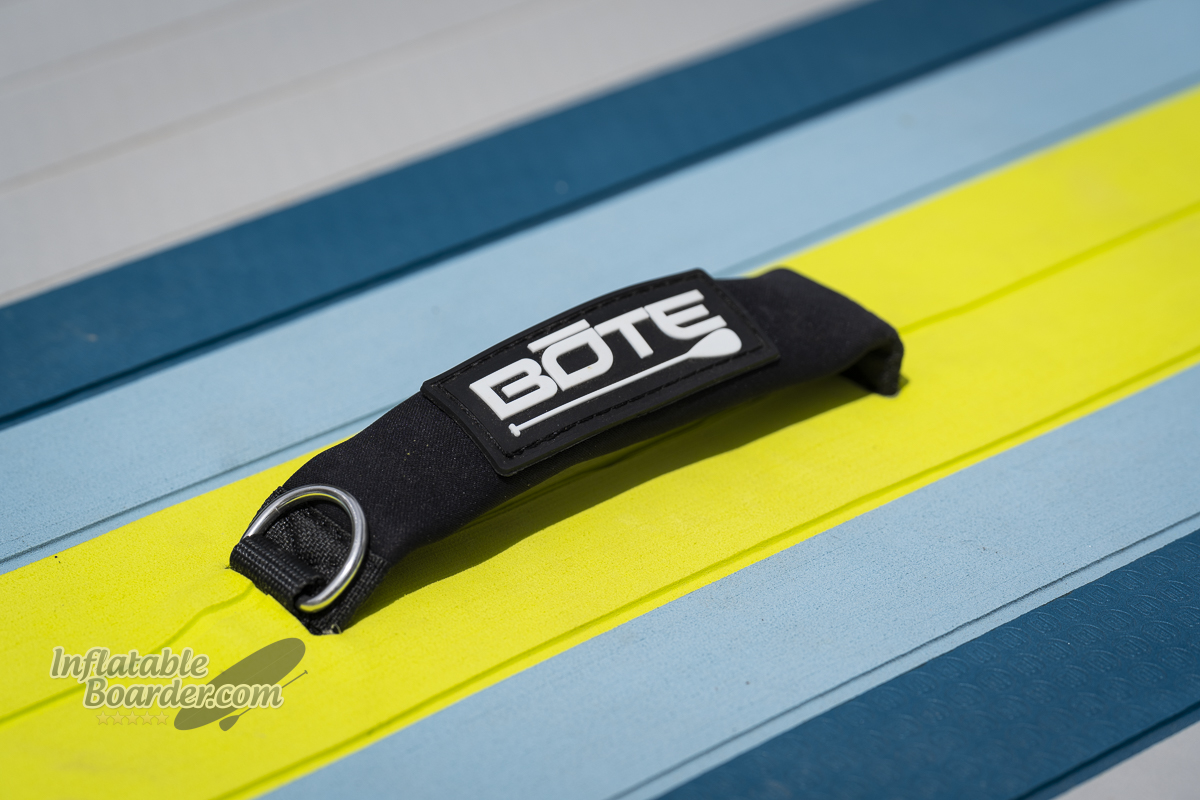
There are three padded carrying handles on the LowRider 10’6 and the center carrying handle also has a secondary leash attachment D-ring.
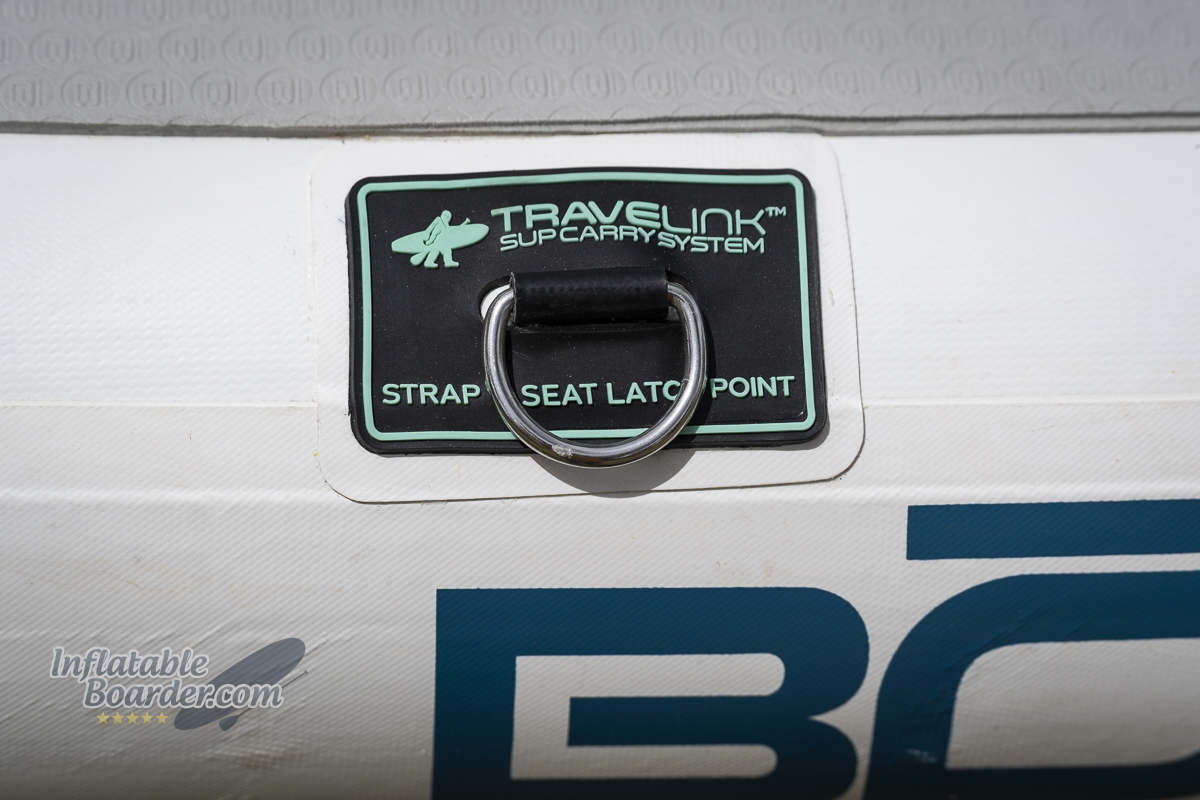
There are six D-rings along the side of the LowRider 10’6 that can be used as additional tie down points and are compatible with the Bote TraveLink shoulder strap and serve as the attachment points for the included inflatable kayak seat.
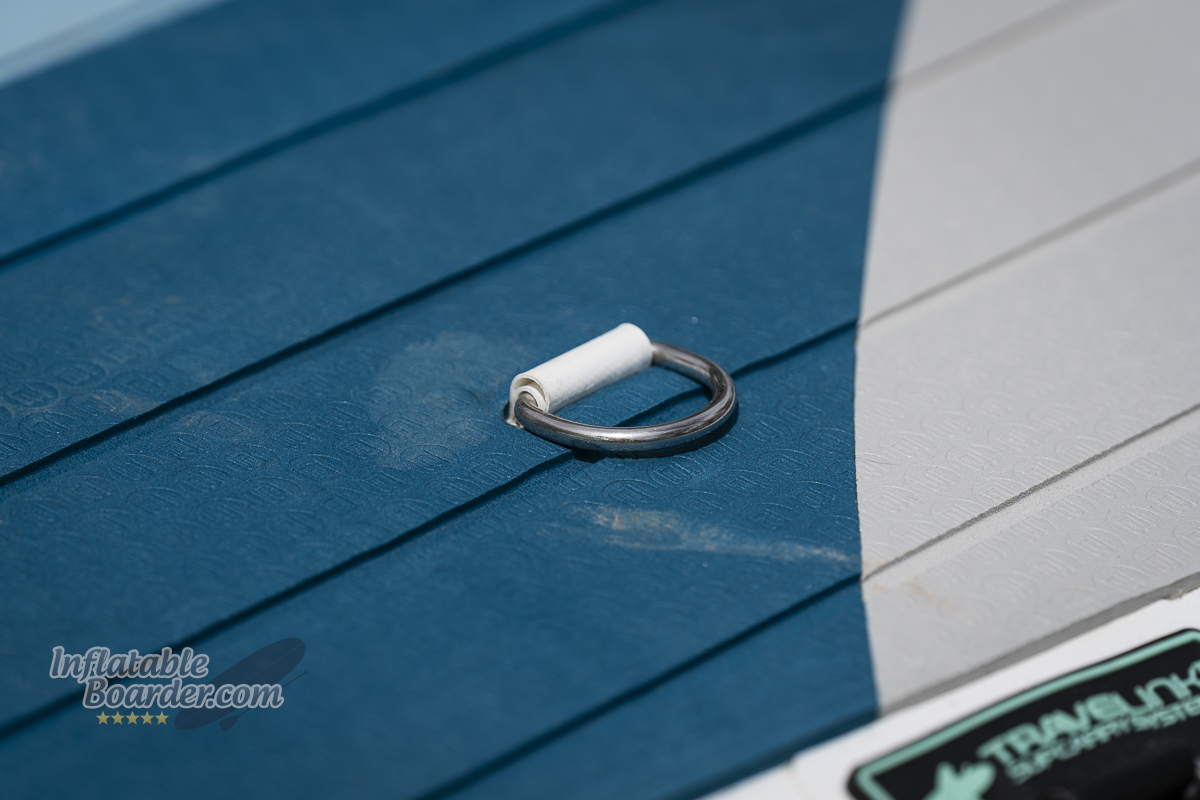
There are two cooler tie-down D-rings behind the standing area.
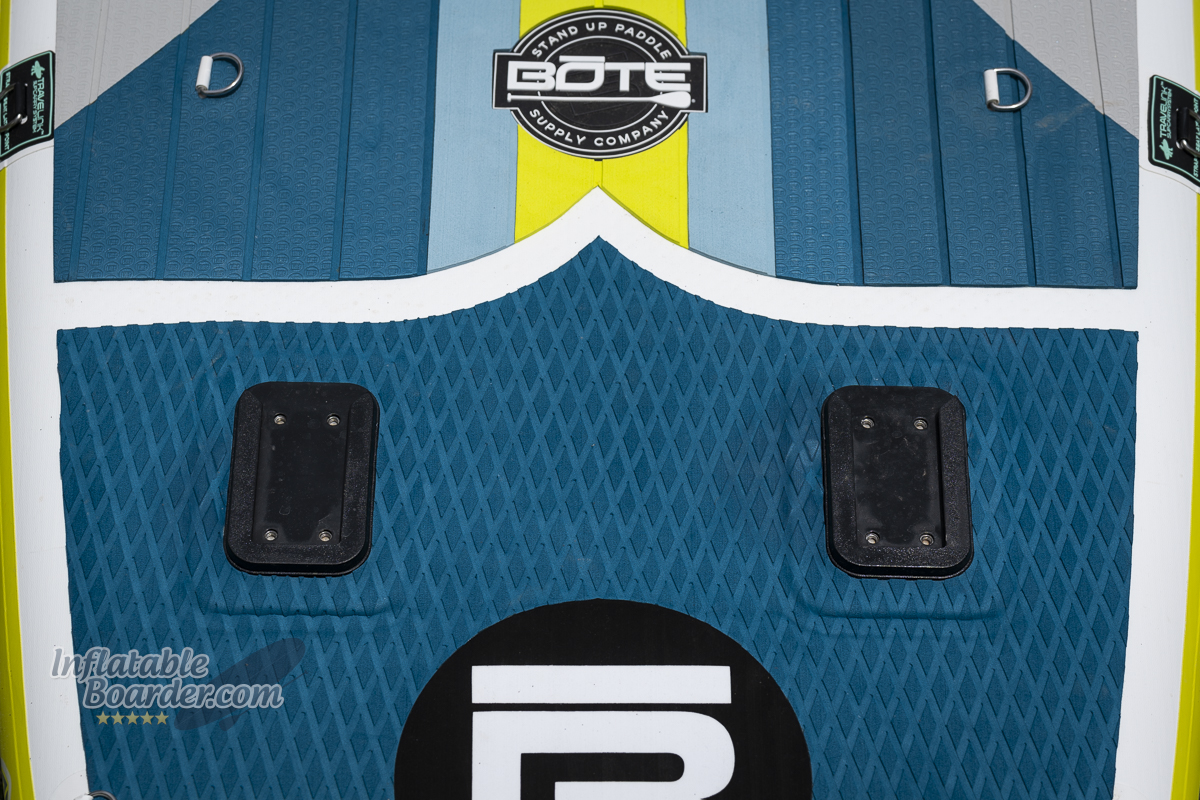
On the rear of the board the deck pad changes from a relatively flat logo-embossed texture to a high-traction diamond groove pattern. There are two slide-in mounting points for the included AeroRack receivers.
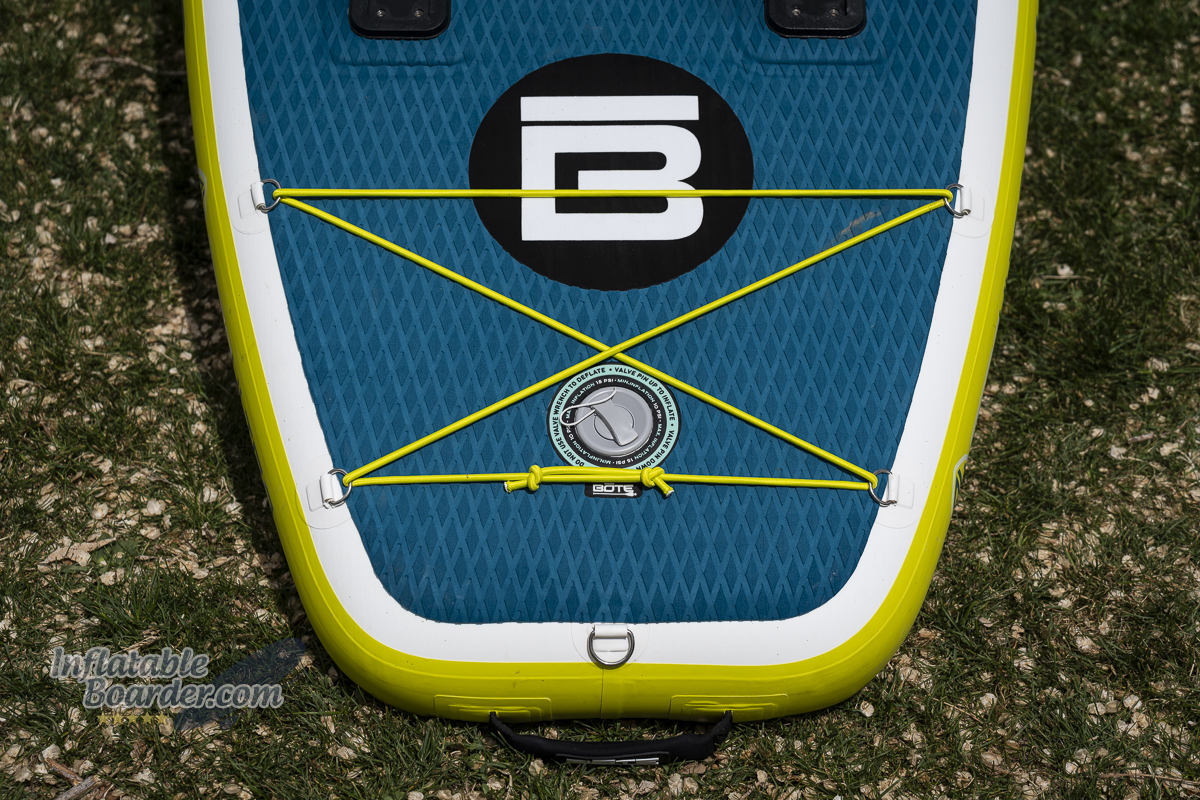
The tail of the board is quite wide and combined with a square shape provides lots of stability. There is an additional cargo area with an adjustable bungee cord, and a leash D-ring here as well.
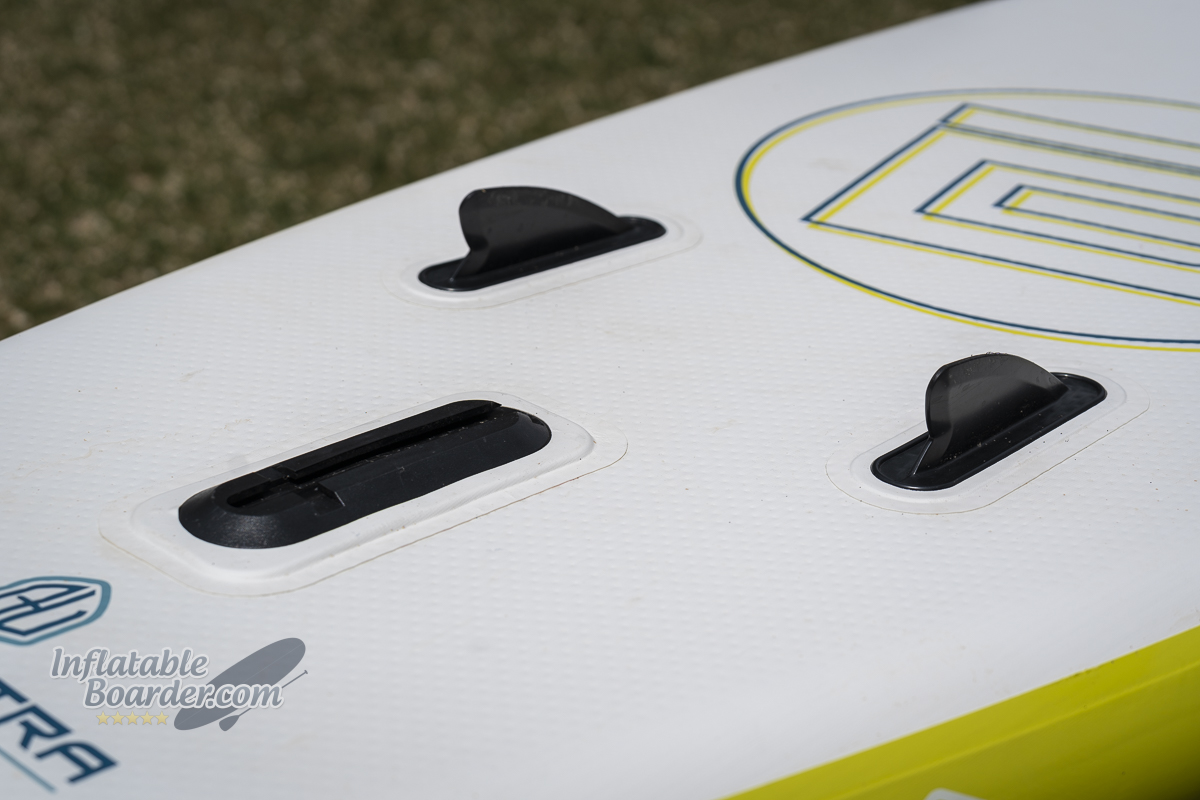
Under the board the LowRider 10’6 has two fixed side bite fins and a single slide-in fin box.
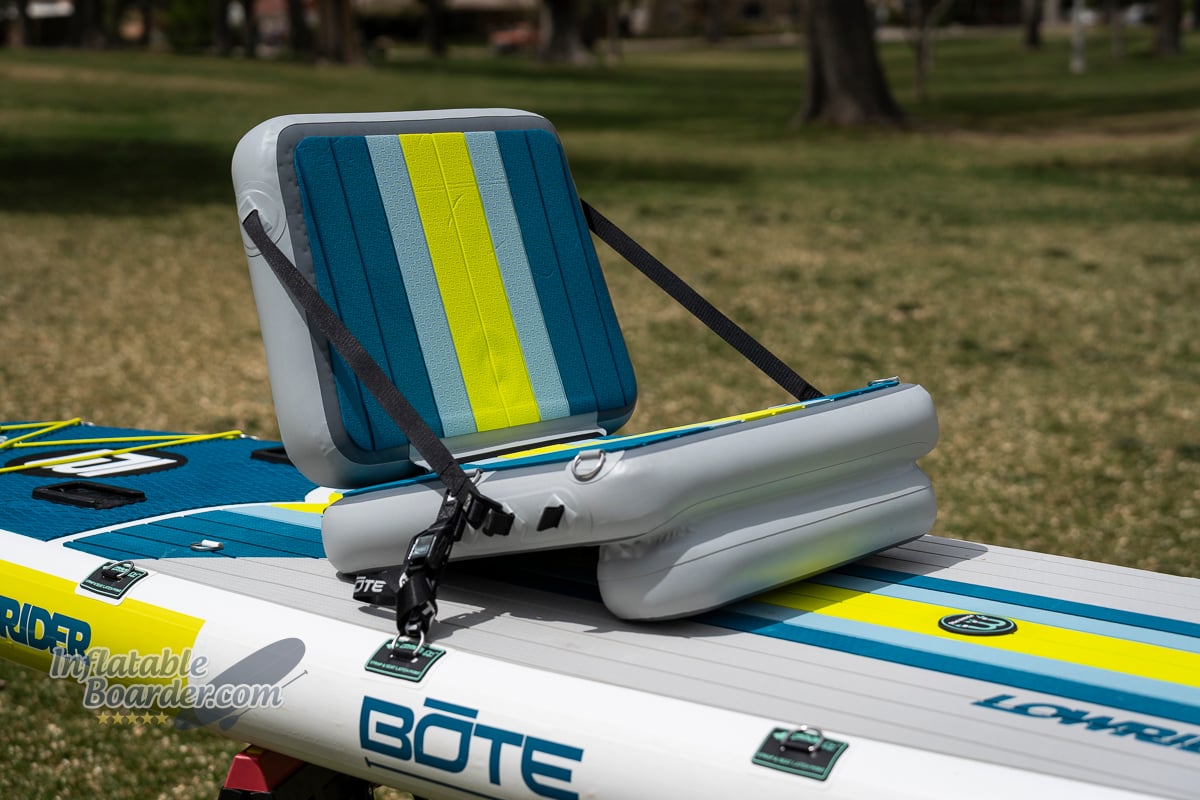
The LowRider 10’6 comes with Bote’s inflatable kayak seat and two 4’ cam straps for quick and easy conversion from SUP to Sit-On-Top kayak and back.
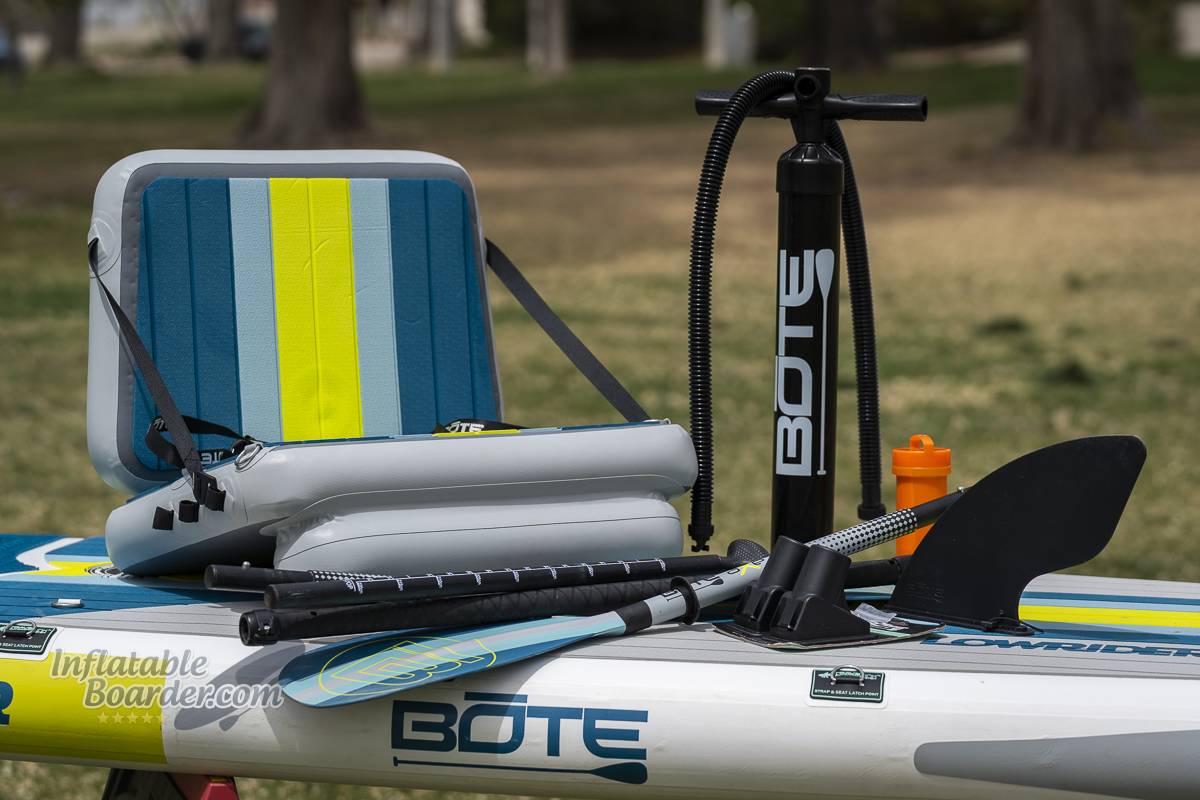
The Bote LowRider 10’6 comes as a mostly complete kit with everything you need to get on the water except a leash and PFD.
The Bote LowRider 10’6 not only has plenty of built-in features on the board for all sorts of paddling activities, but it also comes with a robust set of accessories. Along with the board itself you also get:
- Single chamber hand pump
- Repair kit
- 10” large surface area fin
- Bote AeroRack receiver feet
- Inflatable kayak seat + cam straps
- 3 Piece fiberglass/ABS SUP paddle
- Extra paddle blade for kayaking
All of this comes packaged in a heavy-duty, water-resistant PVC roller backpack. The roller bag is designed specifically for the LowRider including accommodating the inflatable kayak seat. Because of this it is wider than a traditional SUP bag. The padded handle on the top and side of the bag are convenient for lifting, and there is a backpack harness, but at 48 pounds for the full kit I definitely try to use the wheels as much as possible. There are four compression straps on the bag, however they don’t actually work. The fixed side of the straps are as long as the bag is wide, so in its shortest position it applies no compression to the bag. If you do need to carry the LowRider 10’6 on your back, you will feel the contents shifting around because of this.
There is a large zippered pocket on the front of the bag for easy storage of the smaller accessory items, and there is lots of room inside the bag for your daily essentials and PFD.

The new bag for the LowRider (right) is wider than a traditional SUP bag, but does still fit through a standard doorway.
Lastly, it is important to note that while the LowRider 10’6 has two dedicated leash attachment points, Bote does not include a leash with this kit. Leashes and PFDs/Life Jackets are critical pieces of safety equipment for paddlers and should be used appropriately at all times.
Bote LowRider 10’6” Solo Review – Paddle
The LowRider 10’6 comes with a new fiberglass/ABS plastic paddle along with an additional paddle blade to use while seated.

The new Bote Axe paddle has a fiberglass shaft and ABS plastic blade.
This new iteration of the Bote Axe paddle is designed to be used as both a SUP paddle and as a double-bladed paddle for kayaking. The shaft and SUP handle section are both made of fiberglass. This brings the weight down compared to the aluminum version of this paddle, and provides a moderate amount of flex for all-day comfort. Fiberglass is also more impact resistant as it will bend back to its original shape rather than have a permanent bend like aluminum.
The handle section of the paddle has a textured plastic palm grip and length indicators to help you set the paddle to your preferred size. However there is no indexing mechanism, so you do want to check that your handle is properly aligned with the blade each time you adjust the length.
The blade section attaches to the paddle shaft with both a push-button release mechanism and a compression collar, and the shaft is built symmetrically so it does not matter which end you use for the blade and the handle.
The ABS plastic paddle blade is built for durability, so it is a bit heavier than fiber-reinforced nylon blades or composite paddle blades of the same size. This is where fiberglass is actually more comfortable than carbon fiber in the paddle shaft for two reasons. First, the thicker blade does not have as much flex in it, so the fiberglass shaft compensates for this compared to a stiffer carbon fiber shaft. Second, carbon fiber shafts and heavy bladed paddles can often feel unbalanced. The slightly heavier fiberglass material helps keep the paddle feeling comfortable, even if it does weigh a few ounces more than carbon fiber.
The main section of the paddle is covered with a rubberized grip sleeve. Whether or not to add rubberized grip material to a paddle is a very personal choice. I’m not personally a fan of it as I don’t find that I need any additional grip, and I did find this cover to rub my skin a little bit. On the other hand I know several people that add rubberized grips to every paddle they have because they do like the extra traction.
The blade itself is medium-sized with a narrower teardrop shape compared to the previous version. I think this is a huge improvement, especially for paddlers under 160 pounds who don’t need such a large paddle blade. While the blade has a bit of a curved shape, it doesn’t have any dihedral, or center peak, on the power face. I did feel this while using the paddle as I found it has the tendency to flutter and wander more compared to similar size blades with either more curve or more dihedral.
Bote LowRider 10’6” Solo Review – Stability
At 36” wide, the Bote LowRider 10’6 is primed and ready to be extra stable whether you are seated, standing, paddling, or fishing.
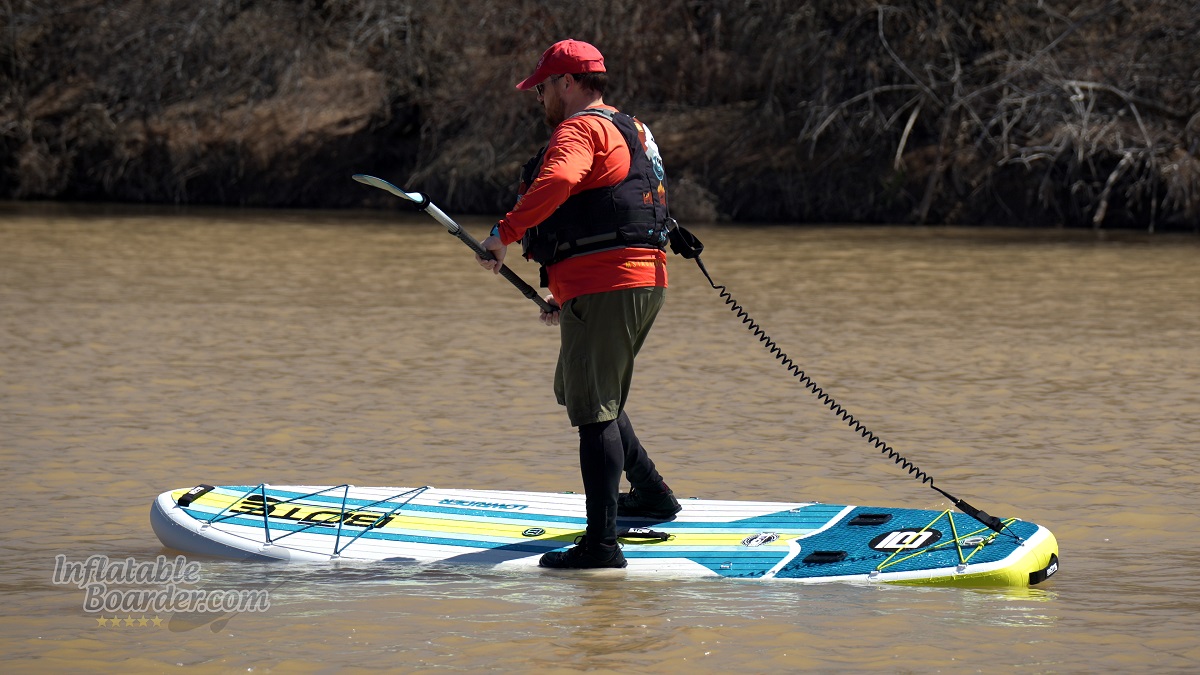
The extra width of the LowRider 10’6 keeps it stable even when balanced on the rail.
The Bote LowRider 10’6 feels incredibly stable while standing and paddling. I didn’t notice any rolling or twitching, not that I was expecting to! As with some other lightweight paddle boards, the LowRider 10’6 is relatively easy to tilt with small weight shifts. Lighter boards are more reactive to small changes in weight distribution than heavier boards. I only really noticed this while I was purposely rocking the LowRider or holding it on its edge.
While rocking the board side to side the rails submerged and resurfaced smoothly without any sudden popping/jerking sensations. However while doing these tests and any time I repositioned myself on the board, I could feel the LowRider flex and reverberate. In the grand scheme of things this does lower the overall maximum stability of the board compared to a more rigid build, but in actual practice the extra wide 36” beam and wide nose and tail make up for the flex.
Once I was back on the tail for a pivot turn, the wide tail had plenty of volume and stability to make smooth and quick pivot turns. I could feel the board flex and reverberate if I had too much of it out of the water, but again, this is more of a fringe case than an actual issue.
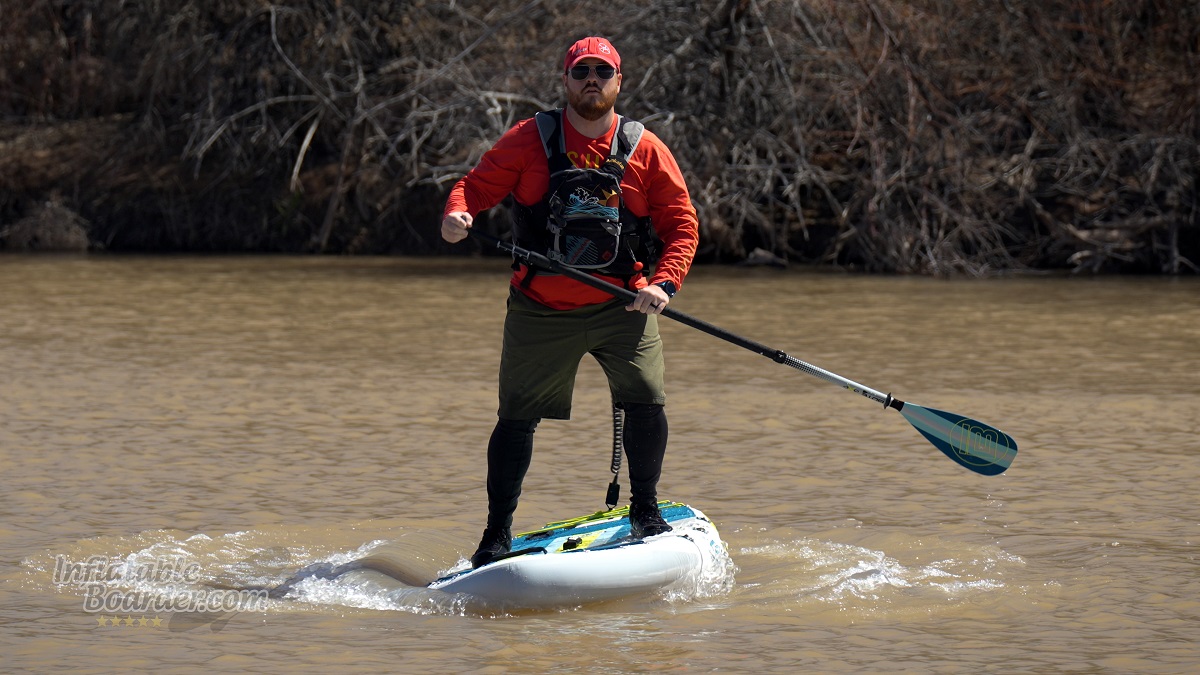
The LowRider 10’6 rocks side to side and recovers smoothly.
Overall I think the LowRider 10’6 is extremely stable and a great option for SUP anglers and/or bringing along a pet or smaller passenger.
Bote LowRider 10’6” Solo Review – Speed
The LowRider 10’6 is an ultra-stable cruiser-style SUP. While it isn’t incredibly fast in a sprint, it does have decent cruising speed and efficiency.
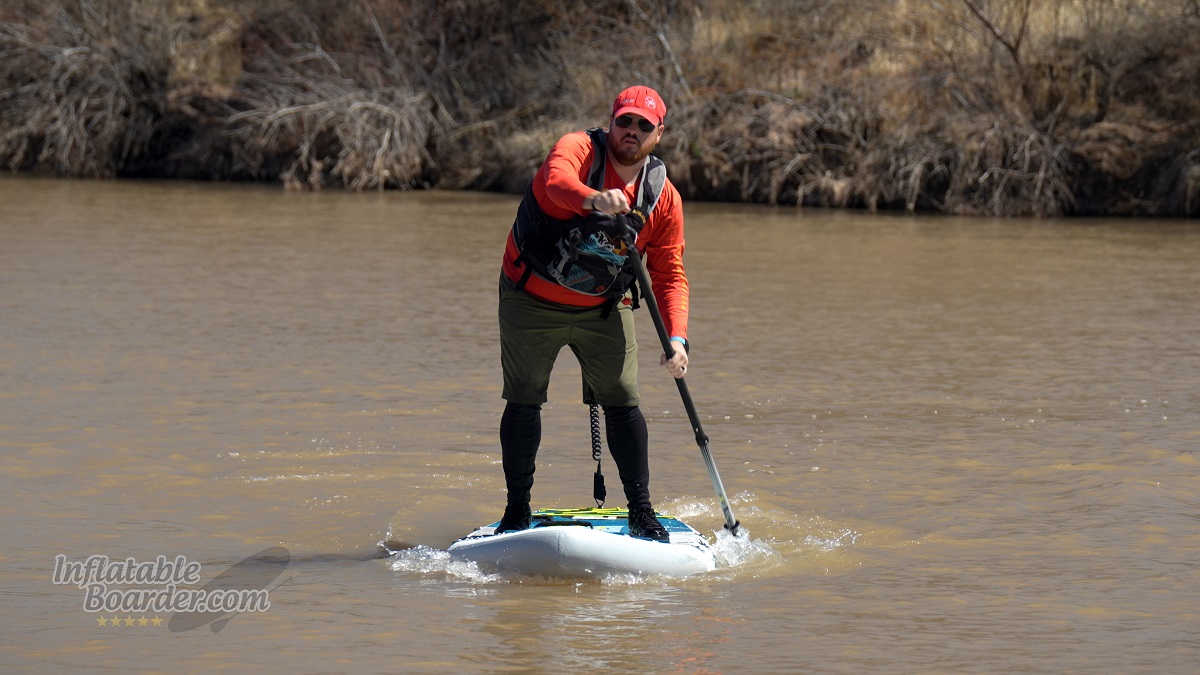
The LowRider 10’6 is slow in a sprint due to its wide shape and less-rigid construction.
In our sprinting speed test we look for both the fastest speed we can attain and a more realistic sustained sprinting speed. With the Bote LowRider 10’6 I was able to reach a peak speed of just 5.2 MPH and a sustained sprint of just 4.8 MPH. While that is relatively slow compared across the more than 100 iSUPs we’ve tested, it’s pretty much exactly where I expected it to be. The LowRider 10’6 isn’t a racing SUP, it’s a cruiser and light fishing SUP, so its top speed isn’t really critical. The 36” width already puts the LowRider 10’6 at a disadvantage for sprinting speeds, and while paddling with this intensity, the board does have significant flex and pushes through the water more than glides.
What does matter is how well it handles under normal paddling conditions.
While paddling at a comfortable cruising pace of around 25 strokes per minute, the Bote LowRider 10’6 performs well for its size. I found the LowRider to move along around 3.3 MPH with easy paddling. I didn’t notice much flex in the board, and the little bit I did feel was mostly just when I was looking for it. I did feel like the board was still a bit pushy in the water, but nowhere near as much as it was while sprinting.
Our gliding efficiency test measures how far a paddle board will travel while cruising before it slows down. The Bote LowRider 10’6 traveled an average of around 18 feet with a single stroke before I could feel it begin to slow down, giving it a gliding ratio of 1.7 board lengths. That’s actually better than I expected given its width and flex.
Overall, the LowRider 10’6 is not going to be incredibly fast, but it’s also not extremely slow. Keeping the 36” width in mind, I actually consider this to be a pretty big win for the LowRider.
Bote LowRider 10’6” Solo Review – Maneuverability and Tracking
With a very large center fin, the Bote LowRider 10’6 Solo favors its tracking ability more than I anticipated based on its size and shape.
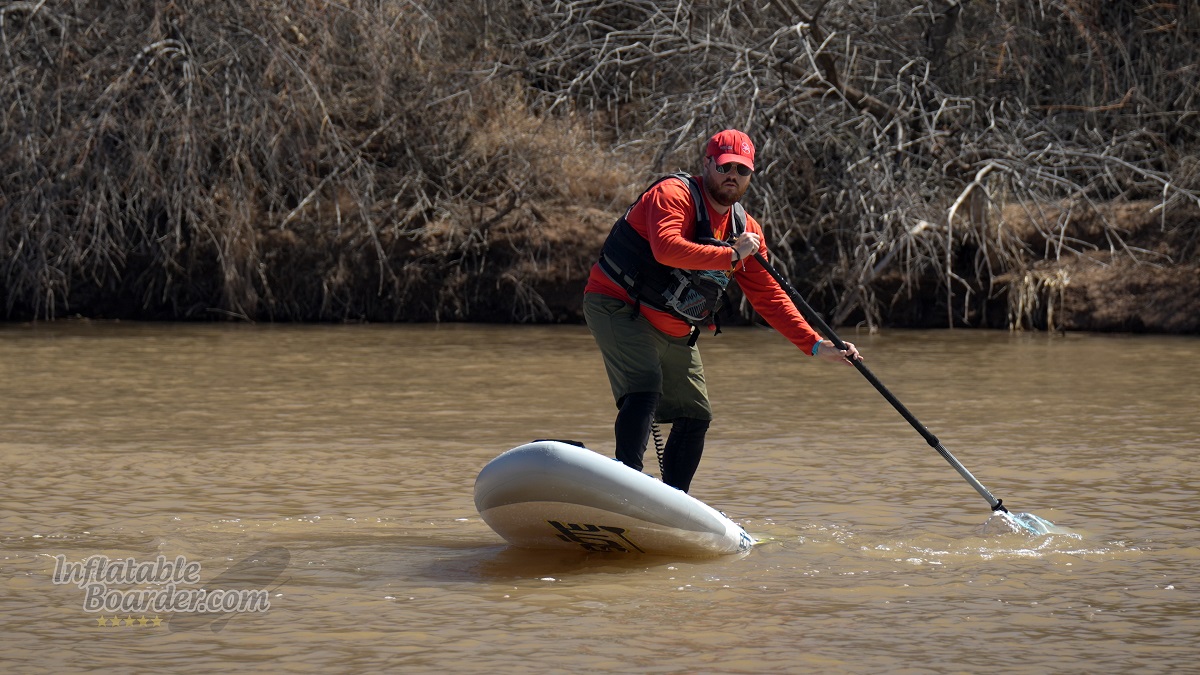
Turning the LowRider 10’6 with forward sweep strokes works OK for small changes in direction, but takes more effort for large turns..
To gauge maneuverability, we perform a standardized stress test that’s designed to really show the difference between different board shapes, sizes, and fin setups. To do this we turn a full 360° circle from a standstill using only forward sweep strokes (paddling in an arc from nose to tail). This is not a very efficient way to make a large turn, but it does show us what each board is capable of.
The LowRider 10’6 completed our forward sweep turning test in an average of 7.75 strokes. That’s definitely on the high side for a standard all-around paddle board and very high for a cruiser-style paddle board – which are generally considered to be maneuverable as a category.
When we ran the test backward with reverse sweep strokes, the LowRider 10’6 did much better and needed just 3.5 strokes on average to turn. That is fairly typical for most paddle boards of this length.
The wide shape of the board and wide tail do lend it to easier pivot turns. Walking to the back of the board is the hardest part because of its flex profile, but once you are standing on the tail the wide square tail is very supportive and makes for quick and easy pivot turns.
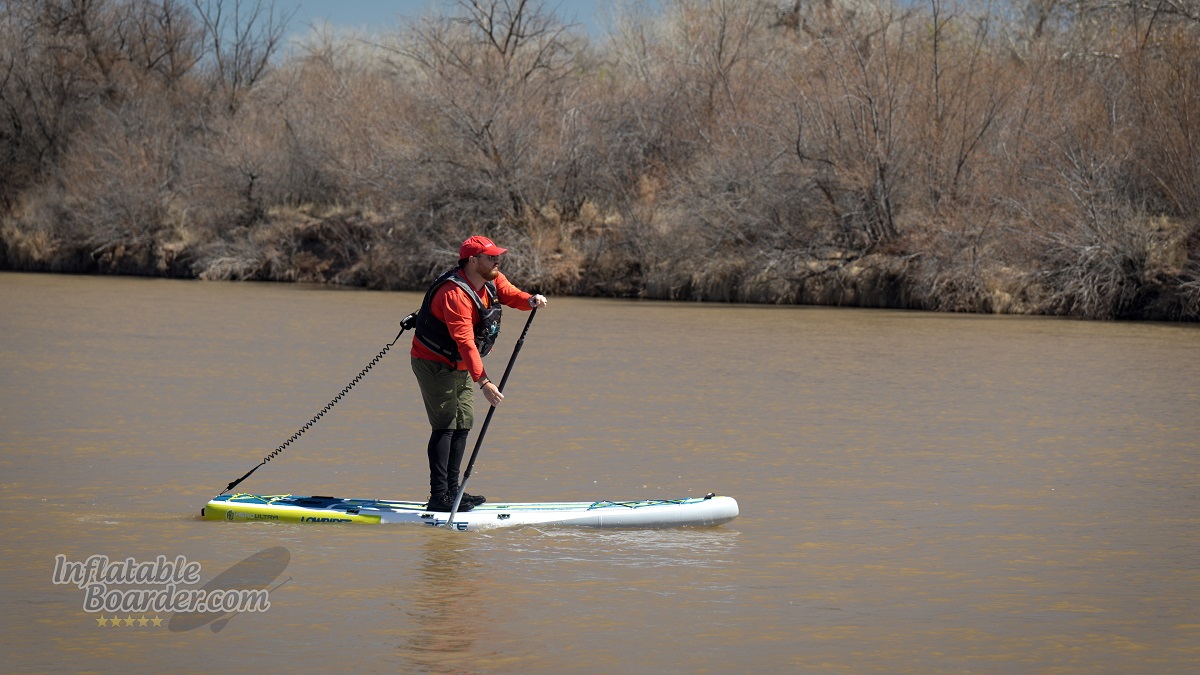
The LowRider 10’6 surprised me with its tracking test result, though real-world paddling didn’t feel quite as good.
While wider cruiser-style SUPs are generally more maneuverable than an all-around board, they also tend to not track quite as well. Similarly to how we put boards through a stress test for agility, we do so for tracking as well by taking 10 paddle strokes on a single side of the board and measuring how far off course the board is pointed at the end.
The LowRider 10’6 actually did quite well for such a wide paddle board, and only deviated an average of 17° off course in our test. That really surprised me because while paddling normally I didn’t really feel like the board did quite that well. I re-ran the test with the same result. Part of the difference, I believe, is likely due to the extra concentration on getting technically correct forward paddle strokes during the test rather than having a slightly “lazy” paddle stroke while cruising around.
Wider paddle boards make taking a proper paddle stroke more difficult as you have to reach much farther to your side in order to keep your paddle straight up and down. When the paddle is angled, then you generate more turning force to the side of the board and tracking performance dips.
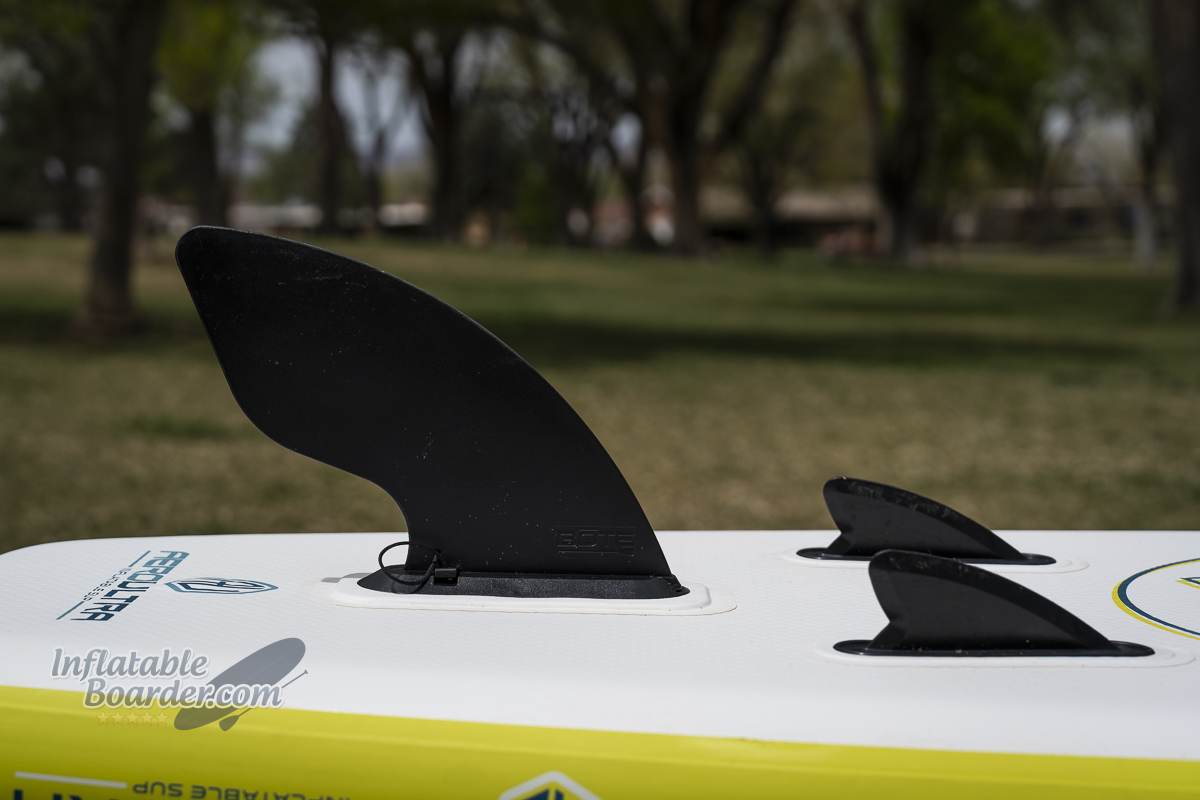
The large 10” center fin is responsible for the Bote LowRider 10’6s interesting turning and tracking performance.
The Bote LowRider 10’6 has a center slide-in fin box and two fixed side bite fins. I honestly don’t know why brands continue to include these vestigial fixed fins. They are purely aesthetic and the only performance impact they actually have is generating drag in the water to slow the board down. If you’ve ever tried paddling a board with just these fixed fins you’ll find yourself spinning in circles like a carnival ride.
But, the LowRider’s included 10” fin is massive. It not only is 10” deep, but also has a ton of surface area and sweep. All of this gives the LowRider 10’6 better tracking ability, but lower maneuverability.
Bote does make a few smaller fin options for this fin box, but it can be hard to find replacement or alternate fins locally. In addition to few options and low availability, I find the slide-in style fin box to be quite frustrating. In theory it’s easy to use, just slide in the fin and insert the key. However, in nearly all of the paddle boards I’ve used, save for a very few, the fin is actually incredibly difficult to install and requires hammering or kicking the fin to get it in and out of the box. I’ve destroyed Hydroflask metal water bottles trying to get these fins in and out of the fin box, and now I keep a hammer (well the back end of a hatchet) in my vehicle mostly to deal with these types of fins. Sometimes the fin boxes will loosen up after a few uses, but not always. When I first received the LowRider 10’6, 11’6, and EasyRider I absolutely had to use extra force to install the fins. Now after a few weeks of testing, one of the fin boxes has loosened up a bit and I can get the fin in without kicking or pounding it into place. The other two still need coercing. The large amount of force often required for these fins also makes it easy to damage the fin box. The plastic fin box is also susceptible to crushing if someone walks on the board while on land, and deformation/cracking if the board is rolled or folded tightly across the fin box.
While the included fin does give the Bote LowRider 10’6 a great amount of tracking for its size and shape, I would like to see Bote adopt a higher quality fin box for their inflatable paddle boards.
Bote LowRider 10’6” Solo Review – Kayak Review
One of the big features of the LowRider 10’6 Solo is its ability to easily transition into a sit-on-top kayak with the included seat and paddle accessories.
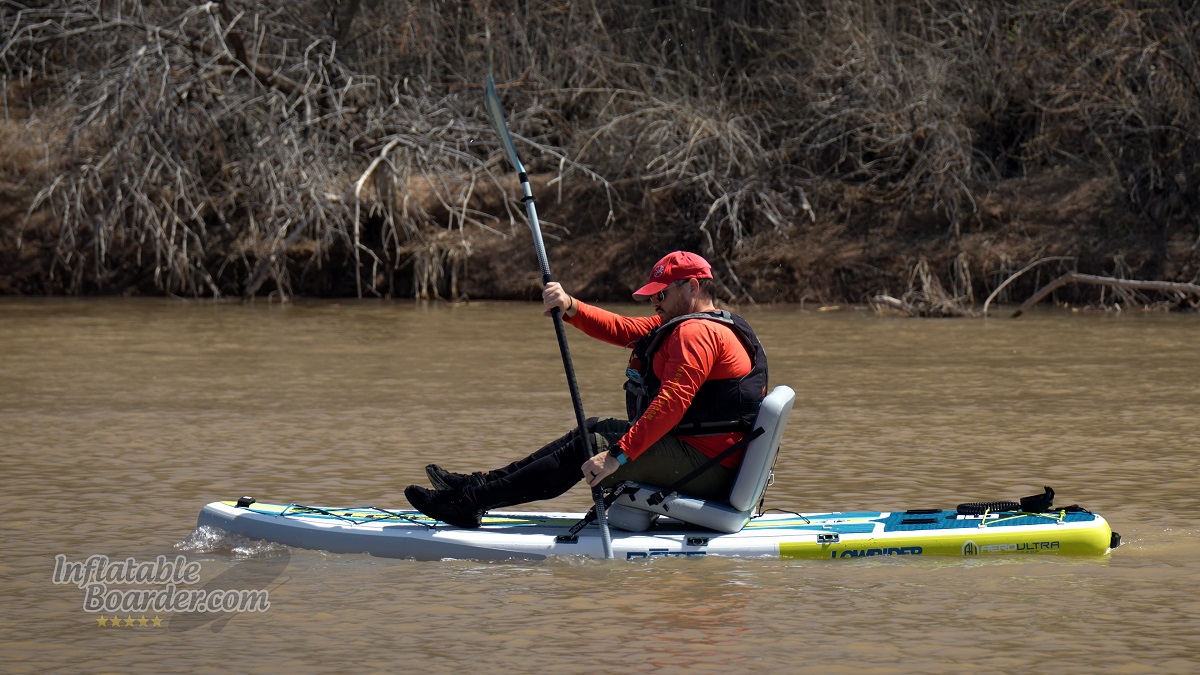
The Bote LowRider 10’6 has a very comfortable and quick kayak conversion kit.
Hands down the Bote inflatable kayak seat is my favorite option for kayak conversions. It’s extremely comfortable and very quick to inflate and adjust. I even use them as regular chairs while camping!
For kayaking, the inflatable seat has a small extra chamber on the front of the seat to change the angle and seat height. This keeps your legs and hips in a more comfortable and ergonomic position. Flat-pad seats force your legs straight out which can reduce blood flow from your hips-down and lead to tingling and numbness in your feet and legs. The seat back adjusts with a quick position change of a G-hook on the small nylon tabs on the side of the seat bottom, and the entire seat is attached to the board with two cam straps. The cam straps have two different positions on the seat bottom and three different options for connecting to the side of the board. This lets you dial in exactly where you want to sit to best distribute your weight and balance it with any heavy cargo or small passengers.
This system is very quick and intuitive, however I do wish it had at least one (if not two) more connection points with the board. With only two attachment points I felt that the seat wasn’t really “connected” with the board, even though it certainly wasn’t going to fall off. This disconnected feeling is further enhanced because there’s no positive placement for your feet. They are left basically dangling in front of you with nowhere to place them or push against the board. Using your legs along with your upper body to paddle gives you a huge efficiency and power boost when paddling seated, and saves your arms from doing as much of the work.
While the lack of a foot brace does reduce paddling efficiency, overall the conversion to sit-on-top kayak is positive. The seat is comfortable and easy to use, and the included paddle blade quickly and effortlessly replaces the paddle SUP handle. The additional paddle blade has a push-button lock on it that connects to the paddle shaft and aligns the two sides of the paddle.
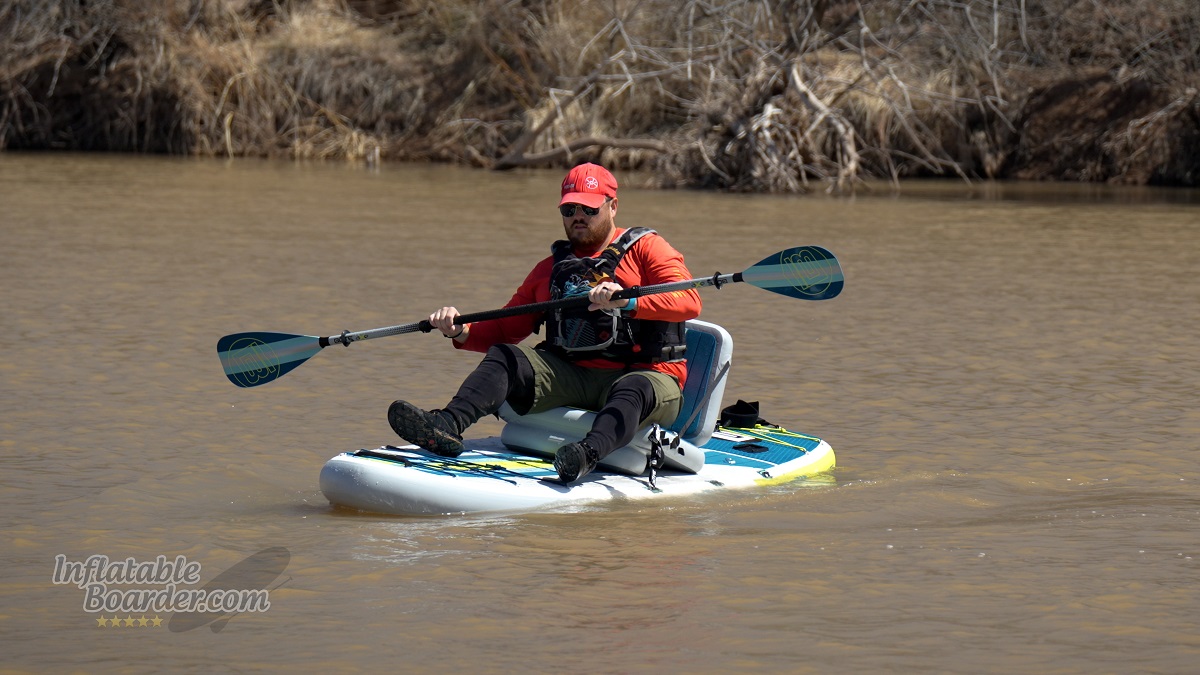
The LowRider 10’6 is very stable as a kayak, and is quite difficult to tilt even when you want to!
As a sit-on-top kayak, the LowRider 10’6 performs very similarly to its use as a stand up paddle board. It’s extremely stable – and even difficult to tilt on purpose – and the double bladed paddle makes it easier to go a little faster and a little straight by alternating strokes on each side of the board. I do feel that the maneuverability is a little lower with less leverage available in a turning stroke by holding the paddle evenly in the middle, but is still quick to steer and make turns up to 90° with much fuss.
If you are looking for an all-in-one package for both seated and standing paddling on a stable platform with the option to bring along all of your fishing gear, a small passenger, and/or pet, then the Bote LowRider 10’6 is a great option.
Bote LowRider 10’6” Solo Review – Warranty and Customer Support
Bote includes a 2 year manufacturer’s warranty with the LowRider 10’6, but only after it is registered with Bote. The bag, paddle, and other accessories are only warrantied for 90 days from the date of purchase. After purchase, users have a 30 day return period for like-new products returned with all accessories. Returns are subject to a 20% restocking fee and the cost of shipping. This is a fairly strict warranty and return policy, and the warranty period extends for what I consider to be the minimum brands should be covering their products. You can contact Bote’s customer service team via web form, website chat, email, or social media.
Bote LowRider 10’6” Solo Review – Final Thoughts
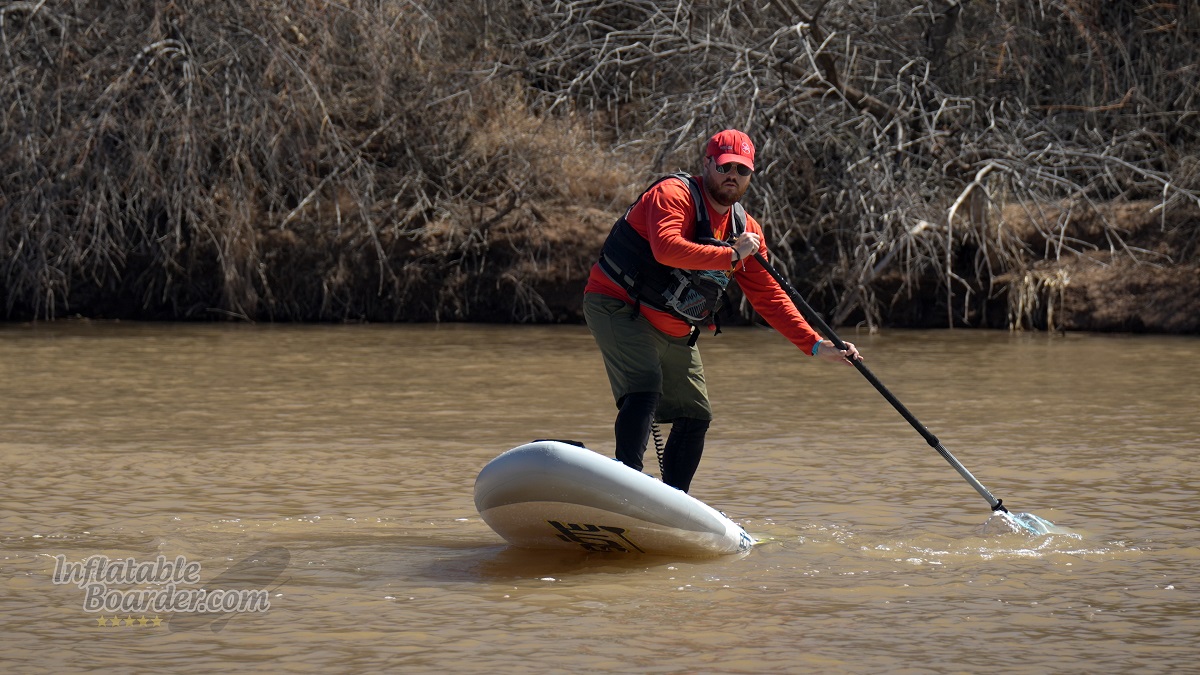
The Bote LowRider 10’6 is a great all-in-one choice for paddlers who want a SUP and kayak for light fishing on smaller bodies of water.
Stability is king for the Bote LowRider. At 36” wide, it’s a great choice for anglers who want to be able to sit or stand – and quickly between the two. The included kayak kit is comfortable and easy to use, and the full length deck pad and fishing tackle mounts make it easy to load up with everything you need. I would recommend the LowRider 10’6 for paddlers under 220 pounds. Heavier paddlers, or those who want to bring along an adult passenger, should check out the Bote LowRider 11’6 Tandem SUP+Kayak package. It performs very similarly, but with more room and more capacity.
Bote LowRider 10’6” Solo Review – FAQ
Does the Bote LowRider 10’6 Solo come with a kayak conversion kit?
Yes, the Bote LowRider 10’6 Solo comes with an inflatable kayak seat and a second paddle blade to convert the SUP paddle into a kayak paddle.
Can I paddle the Bote LowRider 10’6 Solo with a passenger or pet?
Yes and no. For adults wanting to bring a smaller kid or pet with them, the Bote LowRider 10’6 can easily support them and there’s enough room on the full-length deck pad for a comfortable ride. For a second adult passenger or larger pet I would recommend the Bote LowRider 11’6 for its additional room and capacity.
How long does it take to inflate the Bote LowRider 10’6?
The Bote LowRider 10’6 is a large paddle board, and with the single chamber hand pump, expect to spend 12-15 minutes pumping the board depending on how vigorously you pump. I highly recommend an electric pump to completely automate this process, save you some energy, and allow you to finish getting ready to paddle while the board inflates.
Do I need to buy anything else before using the Bote LowRider 10’6 Solo?
Yes. Unfortunately Bote does not include a leash with the Bote LowRider 10’6 Solo. Leashes are key pieces of safety equipment for all paddle boarders along with a properly-fitted PFD/Life Jacket which you will also need.





Leave a Reply